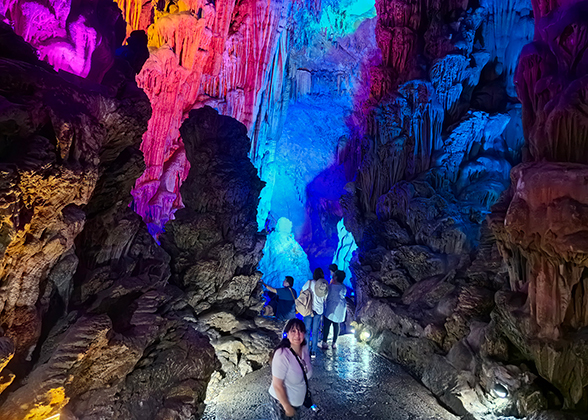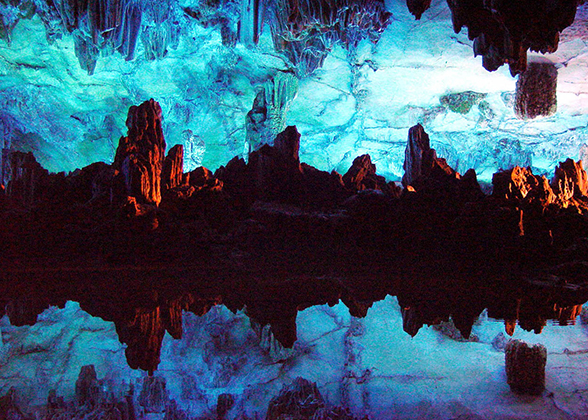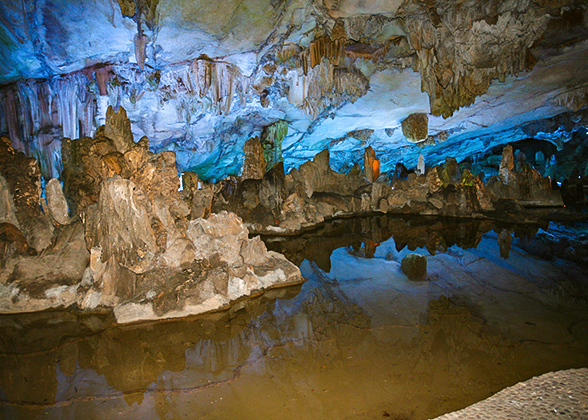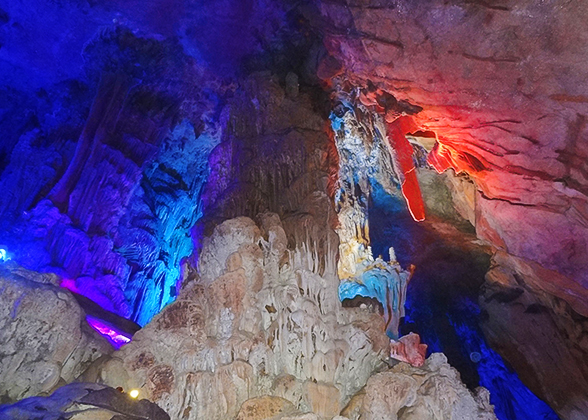Reed Flute Cave
As a brilliant Karst cave marked on almost all travel itineraries, Reed Flute Cave got its name from the verdant reeds growing outside it, with which people make flutes. Actually, inside this water-eroded cave is a spectacular world of various stalactites, stone pillars and rock formations created by carbonate deposition. Illuminated by colored lighting, the fantastic spectacle is found in many variations. Walking through the serried stone pillars, tourists feast their eyes on changing spots, feeling they are in a paradise where the Gods live.
Reed Flute Cave Facts
Location: 5 kilometers (3 miles) northwest of downtown Guilin
Size: 240 meters (262 yards) deep; the maximum height 18 meters (59 ft); the widest point 93 meters (102 yards)
Tour length: about 500 meters (550 yards) long
What’s inside: a spectacular world of various stalactites, stone pillars and rock formations
How old: around 700,000 years old
When discovered: in 1959
Size: 240 meters (262 yards) deep; the maximum height 18 meters (59 ft); the widest point 93 meters (102 yards)
Tour length: about 500 meters (550 yards) long
What’s inside: a spectacular world of various stalactites, stone pillars and rock formations
How old: around 700,000 years old
When discovered: in 1959
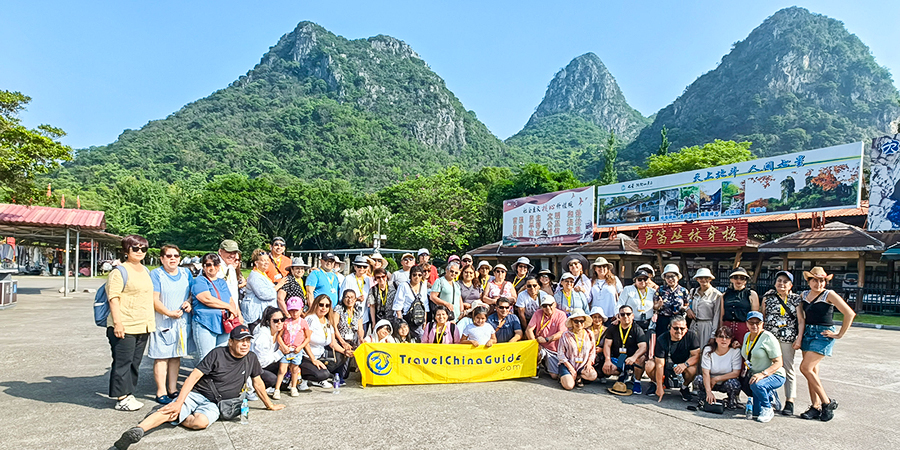 |
How to Tour Reed Flute Cave
Tourists enter the cave and then take a U-shaped sightseeing route to see different spots, whereupon they exit it from another cave quite near the entrance. One trip lasts about forty minutes.
It is a Chinese habit to give each formation a legendary or poetic name such as Crystal Palace, Tower-shaped Pine and other interesting names. For some of these names, you need to use your imagination, but the story behind each is quite fun. It's a pleasure to listen to romantic or fairy tales whilst appreciating the fantastic stone formations.
It is a Chinese habit to give each formation a legendary or poetic name such as Crystal Palace, Tower-shaped Pine and other interesting names. For some of these names, you need to use your imagination, but the story behind each is quite fun. It's a pleasure to listen to romantic or fairy tales whilst appreciating the fantastic stone formations.
Top Spots inside Reed Flute Cave
Tower-shaped Pine (Ta Song Ao Xue)
There are two peculiar stalagmites: one is like a snowman, and because of the coldness, he put his hands into his pockets. Another is like a round tower-shaped pine, whose branches are covered with a thick layer of snow and ice.
Crystal Palace
"Crystal Palace” is the widest part inside Reed Flute Cave. This is a brilliant hall and the height decreases to all sides. The stalactites are hanging up in four directions, and they are like series lanterns decorating the hall. Under the light effects, some stalagmites look like jumping fish.
Leaving Crystal Palace, several narrow lanes appear in front of tourists. According to Chinese myths and legends, this is the place where Monkey King, a main character in Journey to the West, fought with numerous underlings of Dragon King to get his powerful weapon, the magic needle of fixing the sea.
Leaving Crystal Palace, several narrow lanes appear in front of tourists. According to Chinese myths and legends, this is the place where Monkey King, a main character in Journey to the West, fought with numerous underlings of Dragon King to get his powerful weapon, the magic needle of fixing the sea.
Inscriptions on the Cave Wall
Despite the fantastic natural scenery inside Reed Flute Cave, there are many writings on the wall. According to some statistics, there are 77 travelogues and poems left, which are said to be derived from the Tang Dynasty (618-907), making the cave a popular tourist site at that time.
|
|
How was the Reed Flute Cave formed?
Reed Flute Cave is formed by long-term water erosion and carbonate deposition. The rocks inside the cave are mainly limestone. When the underground water flows, it dissolves the calcium carbonate inside the limestone. When the water containing calcium carbonate flows out from underground or drops out from cave roof, the water evaporate, only leaving calcium carbonate. After years of accumulation, stalactites form. Till today, these stalactites inside the cave are still “growing” as the water keeps dropping or flowing.
|
|
How to get to Reed Flute Cave
1. Take city bus 3 and get off at Reed Flute Cave Station.
2. Take City Sightseeing Bus Line 1 to get there. Its running route is Guilin North Railway Station - Folded Brocade Hill - Wave Subduing Hill - Seven Star Park - Reed Flute Cave. It departs from Guilin North Railway Station at 8:30, 11:00, 14:00, 16:30.
Guilin Bus Search
Guilin Bus Search
| Entrance Fee | 1. CNY 90; 2. CNY45 for minors aged 6-18 and seniors over 70. 3. Free for children under 1.2 meters and no more than 6 years old. |
|---|---|
| Opening Hours | 09:00 - 17:00 |
| Recommended Time for a Visit | Three hours |
You May Like
- Last updated on Aug. 30, 2024 by Gabby Li -

